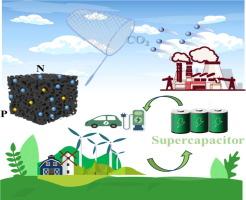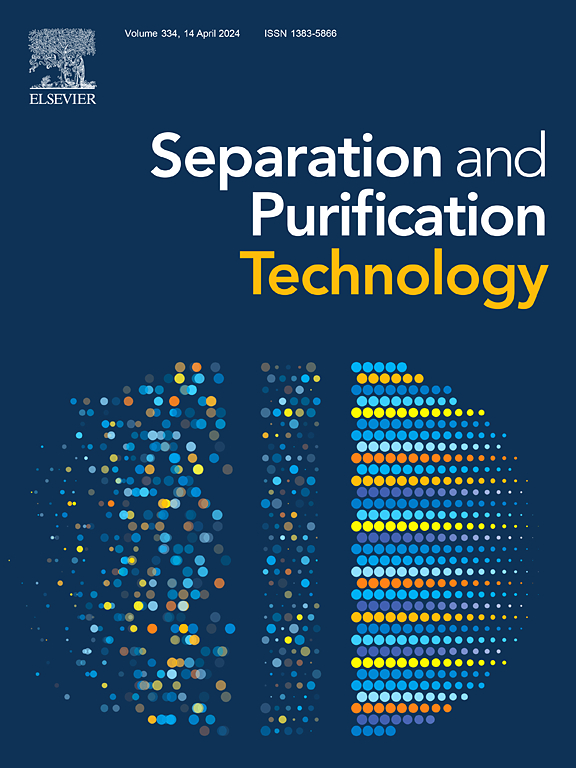N, P co-doped cellulose-based carbon aerogel: A dual-functional porous material for CO2 capture and supercapacitor
IF 8.1
1区 工程技术
Q1 ENGINEERING, CHEMICAL
引用次数: 0
Abstract
Biomass-derived carbon aerogels have attracted considerable attention for applications in CO2 capture and supercapacitors (SCs). However, these carbon aerogel materials often suffer from an insufficient number of active sites. In this study, a novel N, P co-doped porous carbon aerogel with a hierarchical structure was synthesized using cellulose biomass as the raw material, a NaOH/urea system as the solvent and activator, and urea and urea phosphate as heteroatom dopants. Owing to the synergistic effects of heteroatom co-doping and the hierarchical pore structure, the optimal sample, NPCA-600–0.5, exhibited a large specific surface area of 582.9 m2/g and a high pore volume of 0.187 cm3/g. It demonstrated a CO2 adsorption capacity of 2.89 mmol/g (25 ℃, 1 bar), along with high CO2/N2 selectivity and excellent recyclability, retaining 91 % efficiency after 10 cycles. As a SC electrode, NPCA-600–0.5 achieved a high specific capacitance of 238 F/g at 1 A/g, maintaining 80 % of its initial capacitance after 5000 cycles at 10 A/g. This work not only provides a promising adsorbent and electrode material for CO2 capture and supercapacitors, but also offers valuable insights for the design of advanced carbon-based materials.

N、P 共掺纤维素基碳气凝胶:用于二氧化碳捕获和超级电容器的双功能多孔材料
从生物质中提取的碳气凝胶在二氧化碳捕集和超级电容器(SC)中的应用引起了广泛关注。然而,这些碳气凝胶材料往往存在活性位点数量不足的问题。本研究以生物纤维素为原料,NaOH/尿素体系为溶剂和活化剂,尿素和磷酸脲为杂原子掺杂剂,合成了一种具有分层结构的新型 N、P 共掺多孔碳气凝胶。由于杂原子共掺杂和分层孔结构的协同作用,最佳样品 NPCA-600-0.5 具有 582.9 m2/g 的大比表面积和 0.187 cm3/g 的高孔隙率。它的二氧化碳吸附容量为 2.89 mmol/g(25 ℃,1 bar),同时具有较高的 CO2/N2 选择性和出色的可回收性,10 次循环后仍能保持 91% 的效率。作为 SC 电极,NPCA-600-0.5 在 1 A/g 条件下实现了 238 F/g 的高比电容,在 10 A/g 条件下循环 5000 次后仍能保持初始电容的 80%。这项研究不仅为二氧化碳捕集和超级电容器提供了一种前景广阔的吸附剂和电极材料,而且为先进碳基材料的设计提供了宝贵的启示。
本文章由计算机程序翻译,如有差异,请以英文原文为准。
求助全文
约1分钟内获得全文
求助全文
来源期刊

Separation and Purification Technology
工程技术-工程:化工
CiteScore
14.00
自引率
12.80%
发文量
2347
审稿时长
43 days
期刊介绍:
Separation and Purification Technology is a premier journal committed to sharing innovative methods for separation and purification in chemical and environmental engineering, encompassing both homogeneous solutions and heterogeneous mixtures. Our scope includes the separation and/or purification of liquids, vapors, and gases, as well as carbon capture and separation techniques. However, it's important to note that methods solely intended for analytical purposes are not within the scope of the journal. Additionally, disciplines such as soil science, polymer science, and metallurgy fall outside the purview of Separation and Purification Technology. Join us in advancing the field of separation and purification methods for sustainable solutions in chemical and environmental engineering.
 求助内容:
求助内容: 应助结果提醒方式:
应助结果提醒方式:


